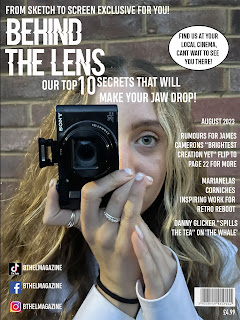Post-production techniques and processes
Task 8: Post-Production techniques and processes (U3:P5)
Learning Outcome 4 (U3): Be able to carry out post-production techniques and processes for an original media product to a client brief.
Front Cover
The target audience of my magazine "Behind the Lens" is a multi-cultural field of people within higher education who receive a low income and live within North London. The front cover has been created to attract my target audience using multiple codes and conventions. An example of this is the model used, the model is a young adolescent girl aged twenty, by creating a natural look with unstyled her the model then creates a sense of normality which would be suitable for the target audience as they can relate more to this. Additionally, props used within the front cover such as the camera; the camera enhances the genre of film production that we want to promote which would attract our target audience.
Another convention used that makes the magazine suitable for our target audience is the use of bold fonts that include only capital letters. The font used on the front cover is Heading Pro; this font is bold and has a modern formality to it which would attract a younger target audience.
The strengths of the front cover are first of all the use of a young model and film production prop. This is a strength as the model helps correlate a relationship between the target audience to the content within the magazine, as well as the camera creates a visual representation of what the content would be about. These visual methods are the easiest way to capture the target audience's attention, therefore the use of them is so effective. However, an improvement of the front cover is the use of natural colors. As seen in my mock front cover this was not planned, nonetheless, the background of a brick wall caused darker colors such as navy blue and black to not match therefore natural colors were a better choice they stood out more.
Double page spread
https://assets.adobe.com/id/urn:aaid:sc:EU:3e78a319-3624-4a91-8655-0f86d7720a6a?view=published
The double-page spread presents what the magazine has to offer and how as a magazine we are able to keep the attention of our target audience without wasting their time. Codes and conventions used within the double-page spread enable it to be suitable to the target audience and the genre of film production.
This can first be seen within the body copy used within the double-page spread. The body copy includes an exclusive interview that personnel working for "Behind the Lens" would have undertaken; the interview here is with Marianela Corniche, a well-known costume designer who recently got a job for "Retro Reboot" an indie film based in North London. The use of this body copy is suitable for the target audience for multiple reasons. First of all, Marianela Corniche discusses how she enjoyed creating costumes for a North London setting, this creates an interest for the target audience as they can relate to North London and understand better what Marianela Corniche is discussing. Additionally, she discusses how she gained success, evidently, this topic of conversation is intriguing as the target audience is people who aspire to this success and want to find out how its achieved. Nonetheless, the body copy is an exclusive interview which is suitable for the target audience as this exclusive information is something we promote on the front cover and fits the purpose of the magazine.
Other codes and conventions used within the double-page spread to make it suitable for the target audience include the model who is Marianela Corniche posing whilst she is casually designing costumes. This image is suitable as it shows even though she is a famous celebrity she still lives a casual lifestyle, this creates trust and better understanding for the target audience as they can still relate to Marianela Corniche and admire her hard work.
One strength of the double-page spread is the use of color coordination across the pages. Coordinating these colors that match the text with the background creates a subconscious flow for the target audience, similar to the Z pattern. Additionally, the use of the cover line next to the model uses an inspiring and intriguing sentence from the body copy to interest the target audience even further.
One improvement of the double-page spread would be to correlate the background the fit the body copy. Initially, the background had a lot of greenery, however, this disrupted the view of the body copy so we had to create a white background. This constraint caused the aestheticness of the double-page spread to not reach its full potential.




Comments
Post a Comment